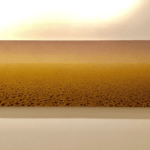
「幻想と現実の構築」Yusuke Nakahara
ヨーロッパ美術の産物であり、外界の景色や物体を生活に忠実に表現してきた「だまし絵」は、1970年代にアメリカの芸術家たちによって新たな段階を迎えた。ハイパーリアリズム、フォーカス・リアリズム、シャープ・リアリズムなど、さまざまな名称で呼ばれるこの改訂傾向は、写真に撮られた風景を絵画に蘇らせることで、リアリズムの生々しさをさらに増大させた。
トロンプ・ユイユ(だまし絵)が写実的な絵画の錯覚によって定義されるのであれば、韓国のテグに生まれ、1982年から日本で画家としてのキャリアを積んできたキム・チャンヨンの絵画は、確かにこのカテゴリーに属する。
しかし、徹底した幻想の世界のみを扱う通常のだまし絵とは異なり、キム・チャンヨンは幻想と現実の両方を同時に理解する新しい構造を導入している。シリーズのタイトルが示すように、キムの作品の基本要素は砂である。キャンバスや木版、藁袋の表面に実際の砂を塗った後、足跡や引っかき傷のような痕跡を手で砂の上に描く。砂が実物である以上、その痕跡も一見すると本物のように見えるが、それは油絵の具で描かれたイリュージョンに過ぎない。
おそらく、ここでキムは砂の表面と痕跡の両方を油絵の具で描いたのだろう。しかし、我々の予想に反して、キムは実際の砂を使うことで、描かれた痕跡の生命感を微妙に高めている。また逆に、実際の砂さえも描かれた幻影のように見えるという目の錯覚を呼び起こすことにも成功している。結果として、このような幻想と現実のマリアージュは、観客の側に新しい相互作用の感覚を提示する。
最近では、キムの素材は包装紙や木版にまで広がっている。さらに、壁に掛けられたタブローとは別に、立体的なボリュームに関する別の実験も行っている。それにしても、イリュージョンとして描かれるものはどこまでもイリュージョンである。砂以外の新素材を導入したのは、幻想的な描写のドラマチックな生命感を強めるためである。
キムの作品は、幻想と現実の共存によって、描写された絵画の本来の性格からの逸脱を試みている。既成の絵画の規範を超越しようとするキムの意図は、結局のところ、現実の直接的な感覚と幻想の複雑さの両方によって構成されている私たちの現実認識への新たなアプローチである。それは確かに注目に値する試みである。
(1990年6月、キム・チャンヨン展の紹介文より)
“Construction of Illusion and Reality” Yusuke Nakahara
Trompe-oeil, the product of European art that had represented the external views and objects exact to the life, went through another phase of development by the American artists in the 1970s. Called as various names such as hyperrealism, focused realism, or sharp realism, the revised tendency augmented even more the lifelikeness of realism by revivifying the photographed landscape into painting.
If trompe-oeil is defined by the pictorial illusion true to life, the paintings of Kim Chang-Young, who, though born in Taegu, Korea, has been pursuing his artistic career in Japan since 1982, certainly belong to this category.
However, unlike the usual trompe-oeil that deals exclusively with the world of thorough illusion, Kim Chang-Young introduces a new structure that comprehends both illusion and reality at the same time. As the title of his series suggests, the basic element of Kim’s work is sand. After coating the actual sand on the surfaces of canvas, wood plate, or straw sack, he describes on the sand the traces of footprints or scratches by hand. At a glance, since the sand is actual, the traces, too, look like the real ones, although they are merely illusions painted in oil colors.
Possibly, here, Kim could paint both the sand surface and the traces in oil colors. However, contrary to our expectation, what Kim does is to subtly enhance the life-like effect of the painted traces by using the actual sand. Also, reversely, he succeeds in evoking the optical illusion in which even the actual sand looks like the painted illusion. In result, this kind of marriage between illusion and reality presents a new sense of reciprocal interaction to the part of audience.
These days, the scope of Kim’s materials has been extended to the wrapping paper and wood plate. Moreover, aside from the tableaus hanging on the wall, he has been making another experiments on three-dimensional volumes. And yet, what is drawn as illusion is illusion to any extent. The introduction of new materials other than sand is simply to intensify the dramatic lifelikeness of illusory description.
By the co-existence of illusion and reality, Kim’s work attempt at a deviation from the inherent character of described painting. Trying to transcend the established norm of painting, what Kim intends to do is to make a new approach to our perception of reality, which, after all, is comprised by both the direct sense of reality and complexity of illusion. It certainly is an attempt worthy of notice.
(From the introduction to Kim Chang-Young’s Exhibition in June, 1990)

CV
1957 Born in Daegu, Korea
1982 Lives in Yokohama, Japan
1984 Graduated from Sokei school of art
1986 Graduated from Tokyo school of art
1991-99 Lecturer of Tokyo school of art
[Selected Solo Exhibitions]
2018
「Kim, Chang-young」(SH GALLERY/Tokyo, Japan)
2017
「KOREAN ARTISTS IN JAPAN」(Korean Cultural Center/Tokyo, Japan)
2016
Galerie Bhak/Seoul, Korea
2013
FEI Art Museum/Yokohama, Japan
2012
Galerie Bhak/Seoul, Korea
2011
Korean Cultural Center/Berlin, Germany
[Awards]
1999
Sharjah Biennial Grand Prize
